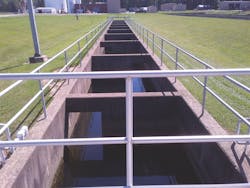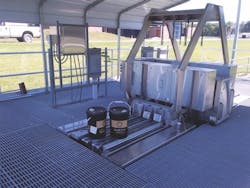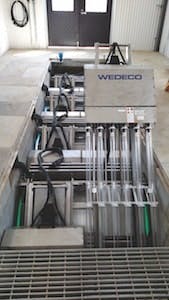UltraViolet, Ultra Green
About the author:
Steven London is president of Steven London Associates. London can be reached at [email protected].
North Ridgeville is a warm, neighborly and growing city of 32,483 located in Lorain County in Northeast Ohio. It was founded in 1810 and incorporated as a city in 1960. The city is located 15 minutes from Cleveland Hopkins International Airport and 30 minutes from downtown Cleveland. At 25 square miles, it is the largest city in land area and third-largest in population in Lorain County.
The French Creek Wastewater Treatment Plant (WWTP) is wholly owned and operated by the citizens of North Ridgeville. The plant serves North Ridgeville, Avon and Sheffield through main underground interceptor sewer lines. North Ridgeville took full ownership of the sewer treatment facility in the latter part of 2008, when all notes were paid in full. The plant services about 12,500 accounts through nearly 300 miles of pipeline, which ultimately returns the treated effluent to French Creek.
The WWTP was built in 1975 by the Ohio Water Development Authorities and was purchased from the state of Ohio by the city of North Ridgeville in 1983. While the plant is only a few decades old, North Ridgeville has continually upgraded and maintained its operations. The city has invested millions of dollars to ensure that the plant remains current with technology and in compliance with ever-changing environmental guidelines.
A before photo of the Trojan 4000 ultraviolet module and banks.
Disinfection Upgrade Needed
Although the WWTP is ready to serve its growing customer base well into the future with safe, sanitary and cost-effective treatment of sewage, it was dealing with a dilapidated Trojan 4000 ultraviolet (UV) system installed in 2000 as its disinfection source. The equipment was labor-intensive. For example, wiring for the lamps was routed inside the lifting arms. As the wiring aged, it would wear out, causing shorts. It was very difficult to “fish” the wire through the arm. Ballast assemblies were located above the channel and were cooled by a glycol loop. Loop tubing leaked, which made the ballast area slippery. The city also found it difficult to locate replacement parts, as the manufacturer was slowly sunsetting the equipment. Finally, the UV system was consuming a large amount of power as it inched closer to the end of its life.
The city needed to identify a replacement UV system that fit into the same channel, offered lower power consumption and provided a practical ease of maintenance to reduce the amount of labor consumed on the equipment.
Working closely with the city’s consulting engineer—Jones & Henry Engineers Ltd. of Toledo, Ohio—North Ridgeville selected the Wedeco Duron UV system over other inclined UV systems due to its energy efficiency and simple maintenance. Duron is a 45-degree inclined, open-channel UV system possessing an integrated, compact, automatic-lifting device and featuring energy-efficient, high-power Ecoray lamps.
Removal of the old system was fairly straightforward. The existing channel was utilized, as the Duron UV banks are narrower than the existing space. The area where the existing UV system was located was demolished and a new level control gate structure was constructed.
The Ecoray 600-W lamps, together with the new lamp orientation, reduced the required lamp count by more than 50% versus conventional low-pressure, amalgam UV lamps. The reduced lamp count is balanced with the 4.6-ft lamp length that is easy for operators to handle. Additionally, reduced channel depth requirements lower building costs, while a small footprint is maintained thanks to the compact inclined design.
The Duron UV system not only provides lower capital costs, but also lower energy consumption. OptiDose—sensor-based, real-time dose control—monitors operating conditions including flow, UV transmittance (UVT) and UV intensity. Then, with control logic, OptiDose adjusts the energy consumption to the minimum needed to meet dosing requirements so the right dose is delivered using the minimum amount of energy.
Optimized hydraulics ensure superior dosage distribution for effective disinfection with reduced energy consumption; this has been proven by extensive third-party validation tests. The system has been validated with multiple challenge organisms, at varying flows and a wide range of UVTs.
Ultraviolet systems can be lifted out of the system for maintenance.
Easily Maintained
Central to the design is the ease and efficiency of the system maintainance and servicing. Large-scale component replacement has decreased, since the Duron system is new. Easy lamp replacement can be conducted while the modules remain in the channel. Dry-top UV lamp access and the compact, integrated, lifting mechanism allow safe and ergonomic maintenance, including inspection of the UV sensor—a new task for the operators. Each module can be lifted individually for any necessary maintenance at a comfortable service height. The lifting system also is designed at a 45-degree angle, maintaining its small footprint.
Cleaning is simple and safe thanks to the Duron’s automatic, chemical-free Opti Wipe system. Wipers consist of unique PTFE and FKM rings, which have been effective even in waters with high fouling potential.
Although some maintenance, such as wiper ring or sensor replacement, requires lifting the module, the automatic mechanism will lift an individual module while other banks of modules remain in service. Operator access requires no crane or additional floor space. The result is continuous treatment, even during maintenance.
For seasonal operations, modules can be lifted out of the channel and left in the raised position, saving storage space and eliminating the potential for equipment breakage. Electrical components are located out of the water and are easily accessible. Ballast cards are separated from UV lamp modules for easy maintenance and operational stability.
Finally, the Duron system does not require any hydraulic system that potentially can leak hydraulic oil into the plant effluent.


